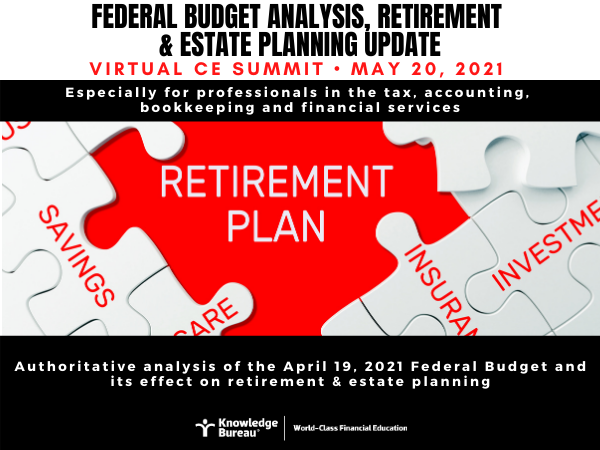Last updated: May 12 2021
How to Take Advantage of the Canada Recovery Hiring Program

Beth Graddon
After gaining 300,000 jobs in March, Canada lost 207,000 jobs in April, primarily in locked down Ontario and British Columbia, according to Statistics Canada. The April unemployment rate also rose 0.6 percentage points to 8.1%. In a timely move, the April 19, 2021 Federal Budget proposed the new Canada Hiring Recovery Program, set to begin June 6, which would help pay for up to 50% of wages. Here is a how-to guide for employers hoping to tap in:
One or the Other. Eligible employers can claim either this hiring subsidy, or the Canada Emergency Wage Supplement (CEWS), which the budget also proposed to extend beyond June 2021.
Maximum Subsidy. This new program would provide eligible employers with a subsidy of up to 50% on incremental remuneration paid to eligible employee between June 6, 2021 and November 20, 2021.
Deadline for application. An application for the hiring subsidy for a qualifying period would be required to be made no later than 180 days after the end of the qualifying period.
Eligible Employers. This program would use the same guidelines for eligible employers at the CEWS, with a few caveats:
- Eligible employers (or their payroll service provider) would be required to have had a payroll account open with the Canada Revenue Agency on March 15, 2020
- A for-profit corporation would be eligible for the hiring subsidy only if it is a Canadian-controlled private corporation (including a cooperative corporation that is eligible for the small business deduction).
- Other eligible employers would include individuals, non‑profit organizations, registered charities, and certain partnerships.
- Corporations and trusts that are ineligible for the CEWS because they are public institutions would not be eligible for the hiring subsidy. Public institutions generally include municipalities and local governments, Crown corporations, wholly owned municipal corporations, public universities, colleges, schools and hospitals.
Eligible Employees. An eligible employee must be employed primarily in Canada by an eligible employer throughout a qualifying period (or the portion of the qualifying period throughout which the individual was employed by the eligible employer).
Furloughed Employees Not Eligible. The hiring subsidy would not be available for furloughed employees. A furloughed employee is an employee who is on leave with pay, meaning they are remunerated by the eligible employer but do not perform any work for the employer.
Sabbaticals, Vacation or Sick Leave Allowed. An employee would not be considered to be on leave with pay for the purposes of the hiring subsidy if they are on a period of paid absence, such as vacation leave, sick leave, or a sabbatical.
Eligible Remuneration and Incremental Remuneration. The types of remuneration eligible for the Canada Emergency Wage Subsidy would also be eligible for the hiring subsidy. Eligible remuneration generally includes salary, wages, Other remuneration for which employers are required to withhold or deduct amounts on account of the employee's income tax obligations.
Not eligible. Remuneration does not include severance pay, or items such as stock option benefits or the personal use of a corporate vehicle.
Incremental remuneration for a qualifying period means the difference between an employer's total eligible remuneration paid to eligible employees for the qualifying period and its total eligible remuneration paid to eligible employees for the baseline period. In both the qualifying period and the baseline period, eligible remuneration for each eligible employee would be subject to a maximum of $1,129 per week.
Non-arm’s Length Employees. As for the Canada Emergency Wage Subsidy, the eligible remuneration for a non-arm's length employee for a week could not exceed their baseline remuneration determined for that week.
Qualifying Period. The remuneration for employees is based solely on remuneration paid in respect of the qualifying period. The applicable dates for the calculation of the incremental remuneration are shown the table below, excerpted from the April 19, 2021 budget.
|
Canada Recovery Hiring Program Dates Used to Calculate Incremental Remuneration, Periods 17* to 22 |
||||||
|---|---|---|---|---|---|---|
|
Qualifying period |
Period 17 |
Period 18 |
Period 19 |
Period 20 |
Period 21 |
Period 22 |
|
Qualifying period dates |
June 6 to July 3 |
July 4 to July 31 |
August 1 to August 28 |
August 29 to September 25 |
September 26 to October 23 |
October 24 to November 20 |
|
Baseline period |
March 14 to April 10, 2021 |
|||||
|
*Period 17 of the Canada Emergency Wage Subsidy would be the first period of the Canada Recovery Hiring Program. |
||||||
Subsidy Amount and Revenue Decline Threshold. Provided that an eligible employer's decline in revenues exceeds the revenue-decline threshold for a qualifying period (see Revenue-Decline Threshold below), its subsidy in that qualifying period would be equal to its incremental remuneration multiplied by the applicable hiring subsidy rate for that qualifying period. See Table 6 below from the Federal Budget:
|
|
||||||
|---|---|---|---|---|---|---|
|
|
Period 17 |
Period 18 |
Period 19 |
Period 20 |
Period 21 |
Period 22 |
|
Hiring subsidy rate |
50% |
50% |
50% |
40% |
30% |
20% |
|
*Period 17 of the Canada Emergency Wage Subsidy would be the first period of the Canada Recovery Hiring Program. |
||||||
Revenue-Decline Threshold. To qualify for a hiring subsidy in a qualifying period, an eligible employer would have to have experienced a decline in revenues sufficient to qualify for the Canada Emergency Wage Subsidy in that qualifying period.
For qualifying periods where the Canada Emergency Wage Subsidy is no longer in effect, an eligible employer would have experience a decline in revenues of more than 10 per cent. In summary:
- More than 0% for the qualifying period between June 6, 2021 and July 3, 2021
- More than 10% for qualifying periods between July 4, 2021 and November 20, 2021
General Approach. An employer's decline in revenues would be determined in the same manner as under the Canada Emergency Wage Subsidy. This method compares the employer's revenues in a current calendar month with its revenues in the same calendar month, pre-pandemic.
Alternative Approach. An employer can also elect to use an alternative approach, which compares the employer's monthly revenues relative to the average of its January 2020 and February 2020 revenues.
A deeming rule provides that an employer's decline in revenues for any particular qualifying period is the greater of its decline in revenues for the particular qualifying period and the immediately preceding qualifying period.
Employers that had chosen to use the general approach for prior periods of the Canada Emergency Wage Subsidy would be required to continue to use that approach for the hiring subsidy. Similarly, employers that had chosen to use the alternative approach would be required to continue to use the alternative approach.
The reference periods set out the table below would be used to determine an eligible employer's decline in revenues for the qualifying periods from June 6, 2021 to November 20, 2021.
|
Canada Recovery Hiring Program Reference Periods, Periods 17* to 22 |
||||||
|---|---|---|---|---|---|---|
|
Timing |
Period 17 |
Period 18 |
Period 19 |
Period 20 |
Period 21 |
Period 22 |
|
General approach |
June 2021 over June 2019 or May 2021 over May 2019 |
July 2021 over July 2019 or June 2021 over June 2019 |
August 2021 over August 2019 or July 2021 over July 2019 |
September 2021 over September 2019 or August 2021 over August 2019 |
October 2021 over October 2019 or September 2021 over September 2019 |
November 2021 over November 2019 or October 2021 over October 2019 |
|
Alternative approach |
June 2021 or May 2021 over average of January and February 2020 |
July 2021 or June 2021 over average of January and February 2020 |
August 2021 or July 2021 over average of January and February 2020 |
September 2021 or August 2021 over average of January and February 2020 |
October 2021 or September 2021 over average of January and February 2020 |
November 2021 or October 2021 over average of January and February 2020 |
|
*Period 17 of the Canada Emergency Wage Subsidy would be the first period of the Canada Recovery Hiring Program. Source: April 19, 2021 Federal Budget. |
||||||
Portions of this article are excerpted from the Special Report on the 2021 Federal Budget. For more important details and interpretations, sign up to receive Knowledge Bureau Report in your inbox and you’ll have access to download the complete report.
Additional educational resources: RSVP now for an analysis of the April 19, 2021 budget and its impact on the future of our economy and financial planning at the May 20 Virtual CE Summit.
